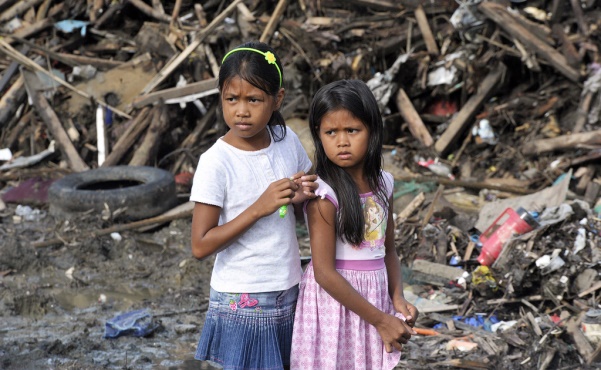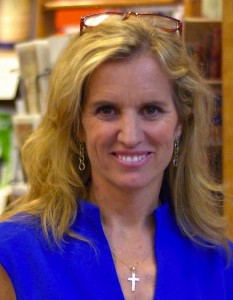Knowledge and experience sharing, along with triangular co-operation, discussed in the session at the High-level Meeting of the Global Partnership for Effective Co-operation in Mexico City in April, 2014, are valuable tools for promoting human security and establishing societies resilient against natural disasters.

“Two girls from Tacloban City, in the Leyte Province of the Philippines, stand in front of some of the damage and debris left by the storm.” UN Photo/Evan Schneider 21 December 2013.
Here is one example from Japan on how these tools can be used. In March, 2011, an unprecedented massive earthquake and tsunami struck our country, resulting in approximately 20,000 dead or missing, 130,000 collapsed houses, and 470,000 evacuees in the aftermath of the earthquake.
But in that catastrophic situation there was no damage to homes in a small coastal village in Iwate Prefecture, despite this being the highest tsunami run-up ever to hit this area: 40 metres above sea level. Why? This village had been hit by a tsunami in 1933, and had kept a record of damages and lessons learned on a stone monument as a way of sharing wisdom on where to build houses to prevent damage by future tsunamis. This knowledge-sharing saved many lives 80 years later.
Though this is just one example of knowledge-sharing across generations in a small village, Japan’s experience demonstrates that a country’s sharing of its knowledge and experience can save precious lives elsewhere. Japan has, tragically, confronted various natural disasters. We are sharing our knowledge and experience through opportunities such as the Third UN World Conference on Disaster Risk Reduction to be held in Sendai, Japan, on 14-18 March, 2015.
Japan is also using triangular co-operation to reduce the risk of disasters. Japan initiated a project to construct Mexico’s National Center for Prevention of Disasters (CENAPRED) and offered grant aid and technical assistance to develop the country’s capacity after Mexico’s massive earthquake in 1985. Through the efforts of both countries, CENAPRED is now a disaster management hub for Latin America and the Caribbean to promote disaster-prevention measures, such as earthquake-resistant infrastructure, earthquake observation, and citizen safety.
Following the earthquake in El Salvador in 2001, Japan and Mexico launched a joint project to establish and promote an earthquake-resistant housing construction model through grant aid and technical co-operation provided by Japan. This project leveraged the strengths and experiences of both Japan and Mexico to maximise development effectiveness. Japan provided equipment and technical experts, including on earthquake-resistant construction, while Mexico sent technical experts to support the effective application of the technology based on their own knowledge, as well as their experiences working with Japan.
Approximately 60,000 people have participated in third-country training programmes so far since Japan started triangular co-operation 40 years ago. Japan will continue to contribute its expertise to promote triangular co-operation around the world.
As well as knowledge and experience sharing and South-South co-operation, the Global Partnership meeting in Mexico also highlighted the importance of partnerships with the private sector to address diversifying development challenges. To achieve sustainable growth, it is necessary to create a virtuous cycle through infrastructure development, using ODA to leverage private investment, create jobs, and raise income standards, to attract further investment.
A people-centred perspective is essential when promoting private investment in developing countries. This includes having as many people as possible enjoy the economic benefits of investment; enhancing social resilience to economic fluctuations, climate change, and natural disasters through investment; and advancing local people’s capacity to promote investment.
Last but not least, Japan is currently revising its ODA Charter. It aims to promote Japan’s development co-operation more effectively by building upon the global discussion on the post-2015 development agenda and through the growing diversification of ODA’s role. In revising the Charter, we would like to stress the importance of strengthening partnerships with various development partners in order to maximise development effectiveness. This is a common principle underpinning both Japan’s ODA and the Global Partnership.
An inclusive partnership among various development actors is indispensable for addressing development issues looking ahead to post-2015. I sincerely hope that the Global Partnership will continue to play a crucial role in further strengthening this alliance.
 Seiji Kihara is Parliamentary Vice-Minister for Foreign Affairs of Japan, and is serving a second term as a member of the House of Representatives. Prior to that, he worked for the Ministry of Finance for 11 years, including a secondment at HM Treasury, U.K. He headed a Japanese delegation for the First High-level Meeting of the Global Partnership for Effective Co-operation in Mexico City in April, 2014.
Seiji Kihara is Parliamentary Vice-Minister for Foreign Affairs of Japan, and is serving a second term as a member of the House of Representatives. Prior to that, he worked for the Ministry of Finance for 11 years, including a secondment at HM Treasury, U.K. He headed a Japanese delegation for the First High-level Meeting of the Global Partnership for Effective Co-operation in Mexico City in April, 2014.
]]>
Dear Cara and Mariah,
Michaela and I (along with your cousins Kick and Saoirse) have just returned from Buena Vista, where we spent the last week [...]]]>
Dear Cara and Mariah,
Michaela and I (along with your cousins Kick and Saoirse) have just returned from Buena Vista, where we spent the last week building a school with RFK Human Rights Award laureate Abel Barrera and five of his staff of human rights defenders, a team of 24 Americans, and an equal number of Me’phaa indigenous people.
Buena Vista is a community of about 150 people in the mountains of Guerrero, Mexico. There are about 700 indigenous communities in the region, and the literacy rate is among the lowest in Mexico, hovering near 50 percent.
For ten years the leaders of Buena Vista traversed the dirt path which is impassible during the five month rainy season, then traveled three hours more on a paved road cut into the Sierra Madre mountains—where chunks the size of tractors have disappeared down the treacherous cliffs below—to reach Chilpancingo, the headquarters of the state government, where they demanded a teacher, a school, supplies, and certification, so their children could exercise the right to education.
And for ten years, the government set forth a litany of excuses or didn’t bother to answer the demands.
As we worked side by side on the school, Marisabelle (38) helped slap mud onto the side of the adobe walls. She had had her first child at age 13, and now her three-year-old granddaughter will attend this school. She said that children between the ages of three and seven years old walk two hours to the closest school in the neighbouring village and two hours back. About three times a month the teacher simply fails to show up and rarely lets students know in advance. But the kids, hungry for an education, make the trip anyway, just in case the teacher is there.
Finally the leaders of Buena Vista contacted Abel Barrera and his team of lawyers and community organisers from the Tlachinollan Human Rights Centre who proposed a lawsuit demanding access to education for the children. This was unprecedented in two important ways. First, there is no legal framework for an entire community to demand a right under the Mexican judicial system. And, second, the lawsuit sought to establish legal accountability for the failure to provide for the right to education. In Mexico, as in our own country and most of the world, the legal mechanisms used to defend political rights like the right to vote, don’t work well for social, economic and cultural rights like the rights to health or education. So this lawsuit will have implications not only for the people of Mexico but for people seeking redress around the world.
After ten years of struggle, almost as soon as the lawsuit was filed – voilà! The government sent a teacher to Buena Vista.
The government then went to the judge and said they had complied with the court order and the case should be dropped. When the judge agreed, the people of Buena Vista appealed the case and demanded not only a teacher but certification and supplies as well.
Then a series of government representatives traveled to Buena Vista, and urged the community to drop the case.
But the community persevered.
Building schools is not the business of the RFK Centre. Helping our RFK Human Rights Award laureates change laws or policies is. So we work side by side with Abel and Santiago to support Tlachinollan’s legal actions, writing amicus briefs and advocating at the federal level in the United States and in Mexico itself.
As part of our work we are currently presenting a case against Colombia regarding the right to education of indigenous people. A decision by the Inter-American Commission and Court would benefit Mexico as well.
But lawsuits can take years, children grow fast, and we pursue justice in the name of Robert Kennedy. Even though he understood the importance of changing the law, when it came to education, Grandpa Bobby didn’t wait.
When the Supreme Court decided Brown vs. the Board of Education, and demanded the integration of all public schools, the ruling fathers of Prince Edward County, Virginia, came up with a plan of resistance. In 1959, they closed down every public school in the county. Overnight, all the white kids went to newly formed private schools, and all the black kids were out of luck. When your Grandpa, Robert Kennedy, became Attorney General, he brought a lawsuit against the county—but he knew it would be years for that suit to wend its way through the courts. So he established the Prince Edward County Free School, recruited teachers from across the country, and that school system became a landmark in the Civil Rights struggle.
We thought it seemed only fitting that, 50 years later, at the urging of your younger sister Michaela, the human rights organisation pursuing justice in Robert Kennedy’s name should help build a school in Buena Vista.
During our trip, we saw sunrises and sunsets and everything in-between, but what we didn’t see were youth—men between the ages of 15 and 30. The one exception was Miciel.
When we asked where all of his contemporaries were, Miciel explained that they had joined the migration trail, some to pick food in Mexico, but most to the United States. Because there is no education in their community, and therefore no jobs and no opportunities for people like him to pursue, there is an entire generation living in a sort of real life Hunger Games. Communities desperate for cash will often agree that each family sends one youth to the United States—in order to make enough to pay community dues. They know the women will likely be raped along the way and that the men may well die crossing the border, but with no education and therefore no hope of a job, El Norte is the only choice.
The first time Miciel tried to emigrate he was 15 years old and he was lost in the desert for nine days; the next time he was imprisoned by Mexican border patrol agents who stole the 1,500 dollars it took him 18 months to save. Finally, on his third attempt, he made it all the way to New York, where he was caught and deported and dumped in one of the most dangerous parts of Mexico. From there, it took him months to get home. Right now, he is planning a fourth attempt.
These are conditions which we would not tolerate for our children or for anyone who works for us; but for someone like Miciel, opportunity means trying to hop the border and then work 80 or 100 hours a week on the migrant trail at minimum wage in awful conditions so his community can survive. Meanwhile the United States Government spends hundreds of millions of dollars to track down people like Miciel and re-deport them.
Our work at the RFK Center is helping Abel and Santiago provide a legal framework, standards and a model for other indigenous villages in Mexico and indeed across the continent—so the three-year-old granddaughter of Marisabelle doesn’t feel like her only option is to cross a border.
Love,
Momma
]]>
I was very pregnant and very happy. I lived in Rome, Italy, and I wanted a home birth.
I wanted music, soft light, friends, baby on my [...]]]>

Safe motherhood for all. By F. Beaumont.
My daughter Esmeralda turns 18 today. Like all parents, I am amazed at how time flies. Like all mothers, I get reminiscent about those days, 18 years ago.
I was very pregnant and very happy. I lived in Rome, Italy, and I wanted a home birth.
I wanted music, soft light, friends, baby on my stomach still attached by umbilical cord, no drugs, and no epidural. A birth by my own rules, not by a cold hospital’s.
I found a group specialized in home births – Il Melograno. Their package included ob-gyn and midwife, courses, support and, more importantly, a woman-friendly feel. A photographer from Marie Claire magazine would do a photo reportage on my happy home birth.
Our premise: pregnancy is neither a disease nor a disability. Pregnancy and birth have become over-medicalized; women should reclaim it from doctors overly fond of control and caesareans. My family, my colleagues and the baby’s father thought I was crazy. Home births are more common now but women still battle to extricate pregnancy and birth out of the hospital realm.
In Brazil, we recently lost a battle for a centre for natural birth in Rio de Janeiro.
Clueless mommy
In my case, at midnight, after 30 hours of labour, I was stuck at 6 cms dilatation – and exhausted. A home birth must be 100 percent natural, so the few drops of oxitocyn to trigger full dilation had to be administered in hospital, three blocks away. There I went. At 2am my daughter was born – and promptly taken away to the nursery.
At 5:30am a nurse literally dumped my baby girl in my arms and left. No instructions on how to feed, nothing. My midwife and friends were coming at 8 am. What to do? I had never been around a newborn. I was like Carrie Bradshaw in Season 2 of Sex and The City – domesticity and motherhood were not part of my landscape.
So there I was, baby on one hand, baby book on the other, trying to figure it out. This is the most ridiculous and pathetic image of modern motherhood, I thought. How did we end here, from birth as a group event to 6 AM loneliness in hospital?
Less than 24 hours later, against hospital rules, I signed waivers absolving doctors of any responsibility and checked myself out.
I went home and turned on the CD player. My daughter’s godmother had been listening to the Rolling Stones: “You can’t always get what you want”. I chuckled.
Two close friends, one in Windhoek and one in London, recently tried a home birth but ended in hospital, just like me. Still, we were happy to go through labour at home.
Meanwhile, many women struggle to have a safe birth – anywhere. About half a million women die in childbirth very year. There are not enough trained midwives to ensure a safe labour, whether at home or at a clinic,

Art by Nelly Romeo Alves, photo by E. Zimbres
At a conference on reproductive health in Berlin last week, the World Health Organisation reported that one woman dies every minute for lack of adequate pregnancy and birth services.
A cruel paradox: the world proffers to revere motherhood but does not make it safe and comfortable for mothers to give birth.
]]>